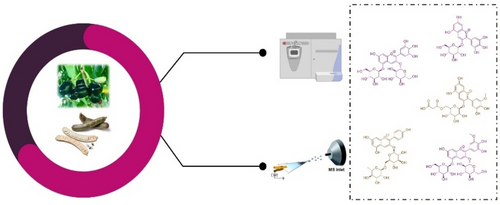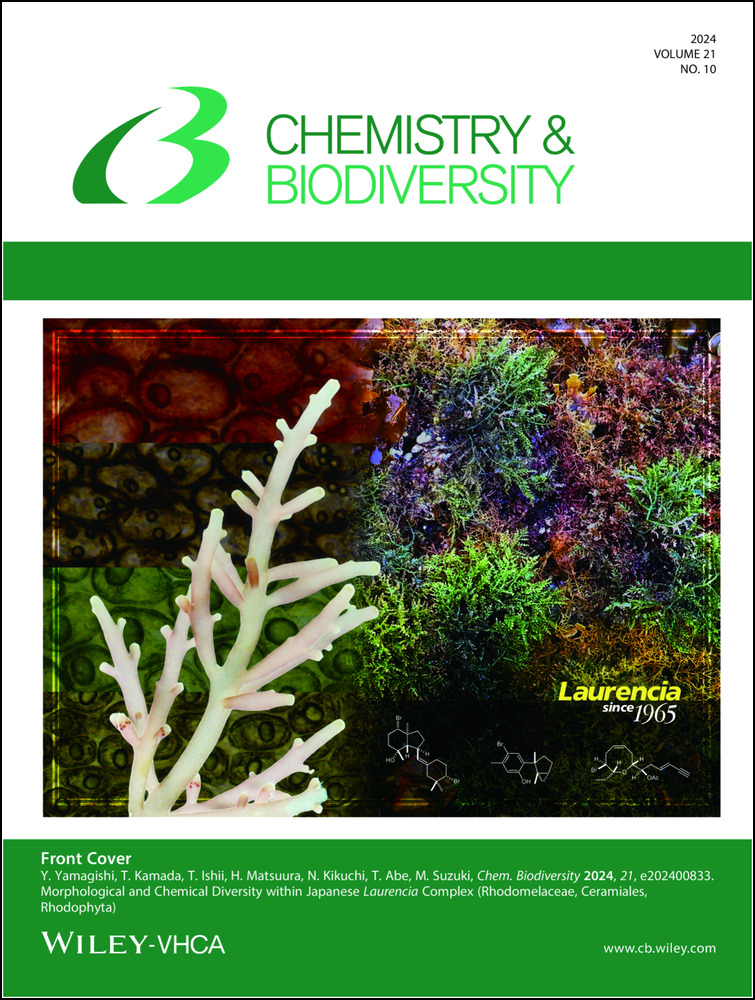Anthocyanin Profiles in the Tropical Fruits Eugenia jambolana and Inga edulis: A Comparative Study Using Paper Spray Ionization (PSI-MS), Tissue Spray Ionization (TSI-MS), and Direct Infusion (DI-MS)
Corresponding Author
Gesiane S. Lima
Chemistry Institute, Federal University of Goias, 74690-900 Goiania (GO), Brazil
Contribution: Conceptualization (equal), Formal analysis (equal), Investigation (equal), Methodology (equal), Validation (equal), Writing - original draft (equal)
Search for more papers by this authorNerilson M. Lima
Chemistry Institute, Federal University of Goias, 74690-900 Goiania (GO), Brazil
Contribution: Conceptualization (equal), Data curation (equal), Formal analysis (equal), Investigation (equal), Methodology (equal), Validation (equal), Writing - original draft (equal)
Search for more papers by this authorNaará S. Balbino
Chemistry Institute, Federal University of Goias, 74690-900 Goiania (GO), Brazil
Contribution: Investigation (supporting), Methodology (supporting), Validation (supporting)
Search for more papers by this authorJean C. P. Sousa
Chemistry Institute, Federal University of Goias, 74690-900 Goiania (GO), Brazil
Contribution: Investigation (supporting), Methodology (supporting)
Search for more papers by this authorGabriel F. Santos
Chemistry Institute, Federal University of Goias, 74690-900 Goiania (GO), Brazil
Contribution: Writing - review & editing (equal)
Search for more papers by this authorBoniek G. Vaz
Chemistry Institute, Federal University of Goias, 74690-900 Goiania (GO), Brazil
Contribution: Supervision (equal), Writing - review & editing (equal)
Search for more papers by this authorCorresponding Author
Gesiane S. Lima
Chemistry Institute, Federal University of Goias, 74690-900 Goiania (GO), Brazil
Contribution: Conceptualization (equal), Formal analysis (equal), Investigation (equal), Methodology (equal), Validation (equal), Writing - original draft (equal)
Search for more papers by this authorNerilson M. Lima
Chemistry Institute, Federal University of Goias, 74690-900 Goiania (GO), Brazil
Contribution: Conceptualization (equal), Data curation (equal), Formal analysis (equal), Investigation (equal), Methodology (equal), Validation (equal), Writing - original draft (equal)
Search for more papers by this authorNaará S. Balbino
Chemistry Institute, Federal University of Goias, 74690-900 Goiania (GO), Brazil
Contribution: Investigation (supporting), Methodology (supporting), Validation (supporting)
Search for more papers by this authorJean C. P. Sousa
Chemistry Institute, Federal University of Goias, 74690-900 Goiania (GO), Brazil
Contribution: Investigation (supporting), Methodology (supporting)
Search for more papers by this authorGabriel F. Santos
Chemistry Institute, Federal University of Goias, 74690-900 Goiania (GO), Brazil
Contribution: Writing - review & editing (equal)
Search for more papers by this authorBoniek G. Vaz
Chemistry Institute, Federal University of Goias, 74690-900 Goiania (GO), Brazil
Contribution: Supervision (equal), Writing - review & editing (equal)
Search for more papers by this authorAbstract
Paper spray ionization (PSI-MS) and tissue spray ionization (TSI-MS) mass spectrometry are simple and rapid ambient ionization mass spectrometry techniques that offer numerous advantages over conventional analysis methods. This study aims to analyze the efficiency of detecting anthocyanins from Eugenia jambolana fruit peel and Inga edulis seeds using PSI-MS, TSI-MS, and DI-MS (direct infusion). DI-MS exhibited high efficiency, detecting all compounds in abundance, with anthocyanins malvidin 3,5-O-diglucoside (1) and petunidin 3,5-O-diglucoside (2) being the most prevalent. PSI-MS, however, struggled to detect delphinidin 3-O-glucoside and showed lower abundances for compounds 1, 2, 3 (delphinidin 3,5-O-diglucoside), and 4 (petunidin 3-O-glucoside) compared to DI-MS, attributed to the technique's challenges with molecular weight and polarity. TSI-MS was least effective, detecting only compounds 1, 2, and 3 at low intensities. The overall unique compounds identified across techniques were 134, emphasizing the importance of comprehensively employing multiple methods to analyze anthocyanins in these edible plants.
Graphical Abstract
Conflict of Interests
The authors declare no conflict of interest.
Open Research
Data Availability Statement
The data that support the findings of this study are available from the corresponding author upon reasonable request.
Supporting Information
As a service to our authors and readers, this journal provides supporting information supplied by the authors. Such materials are peer reviewed and may be re-organized for online delivery, but are not copy-edited or typeset. Technical support issues arising from supporting information (other than missing files) should be addressed to the authors.
| Filename | Description |
|---|---|
| cbdv202400318-sup-0001-misc_information.pdf371.1 KB | Supporting Information |
Please note: The publisher is not responsible for the content or functionality of any supporting information supplied by the authors. Any queries (other than missing content) should be directed to the corresponding author for the article.
References
- 1S. S. Rosales-Murillo, J. Sánchez-Bodón, S. L. Hernández Olmos, M. F. Ibarra-Vázquez, L. G. Guerrero-Ramírez, L. Pérez-Álvarez, J. L. Vilas-Vilela, Polymers (Basel) 2024, 16, 163
- 2Y. Jiang, X. Li, Y. Zhang, B. Wu, Y. Li, L. Tian, J. Sun, W. Bai, Compr. Rev. Food Sci. Food Saf. 2024, 23, 1–33.
- 3Z. Fu, H. Ju, G. Sen Xu, Y. C. Wu, X. Chen, H. J. Li, Food Chem. 2024, 439, 138104.
- 4R. Shimazu, M. Anada, A. Miyaguchi, Y. Nomi, H. Matsumoto, J. Agric. Food Chem. 2021, 69, 11676–11686.
- 5J. G. de Oliveira Filho, A. R. C. Braga, B. R. de Oliveira, F. P. Gomes, V. L. Moreira, V. A. C. Pereira, M. B. Egea, Food Res. Int. 2021, 142, 110202.
- 6G. Mannino, C. Gentile, A. Ertani, G. Serio, C. M. Bertea, Agric. 2021, 11, 1–25.
- 7T. Belwal, G. Singh, P. Jeandet, A. Pandey, L. Giri, S. Ramola, I. D. Bhatt, P. R. Venskutonis, M. I. Georgiev, C. Clément, Z. Luo, Biotechnol. Adv. 2020, 43, 107600.
- 8S. A. T. Lakshan, N. Y. Jayanath, W. P. K. M. Abeysekera, W. K. S. M. Abeysekera, Evid Based Complement Altern. Med. 2019, 19, 916914.
- 9G. C. Vidana Gamage, Y. Y. Lim, W. S. Choo, Front. Plant Sci. 2021, 12, 1–17.
10.3389/fpls.2021.792303 Google Scholar
- 10S. Sutakwa, A. Nadia, L. S. Suharman, J. Agercolere 2021, 3, 31–37.
10.37195/jac.v3i1.123 Google Scholar
- 11W. Huang, Z. Yan, D. Li, Y. Ma, J. Zhou, Z. Sui, Oxid. Med. Cell. Longev. 2018, 2018, 1–10.
10.1155/2018/1862462 Google Scholar
- 12D. D. Herrera-Balandrano, Z. Chai, T. Beta, J. Feng, W. Huang, Trends Food Sci. Technol. 2021, 118, 808–821.
- 13A. Cheng, H. Yan, C. Han, W. Wang, Y. Tian, X. Chen, Int. J. Biol. Macromol. 2014, 69, 382–387.
- 14Y. Liu, Q. Wang, K. Wu, Z. Sun, Z. Tang, X. Li, B. Zhang, Crit. Rev. Food Sci. Nutr. 2022, 63, 12102–12125.
- 15M. Xu, K. A. Bower, S. Wang, J. A. Frank, G. Chen, M. Ding, S. Wang, X. Shi, Z. Ke, J. Luo, Mol. Cancer 2010, 9, 285.
- 16D. X. Hou, K. Kai, J. J. Li, S. Lin, N. Terahara, M. Wakamatsu, M. Fujii, M. R. Young, N. Colburn, Carcinogenesis 2003, 25, 29–36.
- 17A. M. Mudd, T. Gu, R. Munagala, J. Jeyabalan, N. K. Egilmez, R. C. Gupta, Cancer Prev. Res. 2020, 13, 41–52.
- 18H. Song, X. Shen, F. Wang, Y. Li, X. Zheng, Mol. Nutr. Food Res. 2021, 65, 2001090.
- 19S. Lee, K. I. Keirsey, R. Kirkland, Z. I. Grunewald, J. G. Fischer, C. B. de La Serre, J. Nutr. 2018, 148, 209–219.
- 20F. Les, G. Cásedas, C. Gómez, C. Moliner, M. S. Valero, V. López, J. Physiol. Biochem. 2021, 77, 109–131.
- 21A. Heydemann, J. Diabetes Res. 2016, 2016, 1–14.
- 22J.-L. Tian, X. Si, C. Shu, Y.-H. Wang, H. Tan, Z.-H. Zang, W.-J. Zhang, X. Xie, Y. Chen, B. Li, J. Agric. Food Chem. 2022, 70, 1182–1195.
- 23A. Jurgoński, J. Juśkiewicz, Z. Zduńczyk, Plant Foods Hum. Nutr. 2008, 63, 176–182.
- 24T. Tsuda, F. Horio, K. Uchida, H. Aoki, T. Osawa, J. Nutr. 2003, 133, 2125–2130.
- 25D. E. Roopchand, P. Kuhn, L. E. Rojo, M. A. Lila, I. Raskin, Pharmacol. Res. 2013, 68, 59–67.
- 26P. M. Solverson, T. R. Henderson, H. Debelo, M. G. Ferruzzi, D. J. Baer, J. A. Novotny, Nutrients 2019, 11, 2876.
- 27E. Park, I. Edirisinghe, H. Wei, L. P. Vijayakumar, K. Banaszewski, J. C. Cappozzo, B. Burton-Freeman, Mol. Nutr. Food Res. 2016, 60, 1099–1109.
- 28L. Yang, Y. Qiu, W. Ling, Z. Liu, L. Yang, C. Wang, X. Peng, L. Wang, J. Chen, Eur. J. Nutr. 2021, 60, 1935–1944.
- 29P. Li, D. Feng, D. Yang, X. Li, J. Sun, G. Wang, L. Tian, X. Jiang, W. Bai, Trends Food Sci. Technol. 2021, 117, 205–217.
- 30J. Wei, G. Zhang, X. Zhang, D. Xu, J. Gao, J. Fan, Z. Zhou, J. Agric. Food Chem. 2017, 65, 5973–5984.
- 31L. Pogačnik, K. Pirc, I. Palmela, M. Skrt, K. S. Kim, D. Brites, M. A. Brito, N. P. Ulrih, R. F. M. Silva, Brain Res. 2016, 1651, 17–26.
- 32J. Lee, C. Rennaker, R. E. Wrolstad, Food Chem. 2008, 110, 782–786.
- 33J. M. Kong, L. S. Chia, N. K. Goh, T. F. Chia, R. Brouillard, Phytochemistry 2003, 64, 923–933.
- 34D. V. A. de Aguiar, G. da S. Lima, J. V. Roque, J. V. A. Oliveira, I. M. Junio, A. de O. Gomes, L. A. N. Mendes, B. G. Vaz, Anal. Chem. 2023, 95, 6507–6513.
- 35I. Pereira, S. R. M. Rodrigues, T. C. de Carvalho, V. V. Carvalho, G. S. Lobón, J. F. P. Bassane, E. Domingos, W. Romão, R. Augustid, B. G. Vaz, Anal. Methods 2016, 8, 6023–6029.
- 36M. Yu, R. Wen, L. Jiang, S. Huang, Z. Fang, B. Chen, L. Wang, Food Chem. 2018, 268, 411–415.
- 37N. M. Lima, G. S. Lima, G. F. dos Santos, G. Preet, L. I. L. Maciel, T. de J. A. S. Andrade, M. Jaspars, A. R. Chaves, B. G. Vaz, Metabolites 2023, 13, 367.
- 38C. W. Klamp, M. Himmelsbach, Anal. Chim. Acta 2015, 890, 44–59.
- 39G. da S. Lima, I. Pereira, L. I. L. Maciel, N. M. Lima, G. L. Araujo, D. V. A. de Aguiar, G. F. Dos Santos, B. G. Vaz, J. Am. Soc. Mass Spectrom. 2023, 34, 2461–2468.
- 40L. W. Sumner, A. Amberg, D. Barrett, M. H. Beale, R. Beger, C. A. Daykin, T. W.-M. Fan, O. Fiehn, R. Goodacre, J. L. Griffin, T. Hankemeier, N. Hardy, J. Harnly, R. Higashi, J. Kopka, A. N. Lane, J. C. Lindon, P. Marriott, A. W. Nicholls, M. D. Reily, J. J. Thaden, M. R. Viant, Metabolomics 2007, 3, 211–221.
- 41M. Yang, J. Li, C. Zhao, H. Xiao, X. Fang, J. Zheng, Crit. Rev. Food Sci. Nutr. 2023, 63, 3750–3770.
- 42M. M. Giusti, D. G. L. E. Rodríguez-Saona, R. E. Wrolstad, J. Agric. Food Chem. 1999, 47, 4657–4664.
- 43G. McDougall, I. Martinussen, D. Stewart, J. Chromatogr. B 2008, 871, 362–369.
- 44G. F. dos Santos, N. M. Lima, G. S. Lima, J. V. Roque, G. Preet, E. Oppong-Danquah, T. J. A. S. Andrade, M. Jaspars, B. G. Vaz, South Afr. J. Bot. 2023, 163, 121–134.
10.1016/j.sajb.2023.10.030 Google Scholar
- 45A. M. S. Santos, R. C. Faria, I. Pereira, L. A. S. de Lima, C. M. Leal, A. R. Nascimento, R. C. Simas, N. M. Lima, B. G. Vaz, J. Food Compos. Anal. 2022, 109, 104467.
- 46A. L. C. C. Ramos, M. R. Silva, H. de O. P. Mendonça, A. C. do C. Mazzinghy, V. D. M. Silva, B. G. Botelho, R. Augusti, R. M. de S. B. Ferreira, I. M. N. de Sousa, P. Batista-Santos, R. L. B. de Araújo, J. O. F. Melo, Food Res. Int. 2022, 160, 111687.
- 47N. Zhang, Y. Li, Y. Zhou, J. Hou, Q. He, X.-G. Hu, Y.-M. Jia, C.-Y. Yu, Z. Nie, Anal. Methods 2013, 5, 2455.
- 48S. L.-F. Chan, M. Y.-M. Wong, C.-M. C. Ho-Wai Tang, K.-M. Ng, Rapid Commun. Mass Spectrom. 2011, 25, 2837–2843.
- 49A. C. Dametto, D. Agustoni, T. F. Moreira, C. V. Plaza, A. M. Prieto, T. G. A. Silva, F. O. Souza, N. Boralle, J. Maria Sorbo, D. H. S. Silva, C. P. Soares, J. Funct. Foods 2017, 36, 490–502.
- 50N. M. Lima, T. O. R. Falcoski, R. S. Silveira, R. R. Ramos, T. J. A. S. A. Andrade, P. I. Costa, F. A. La Porta, M. V. A. Almeida, Nat. Prod. Res. 2020, 34, 2832–2836.





